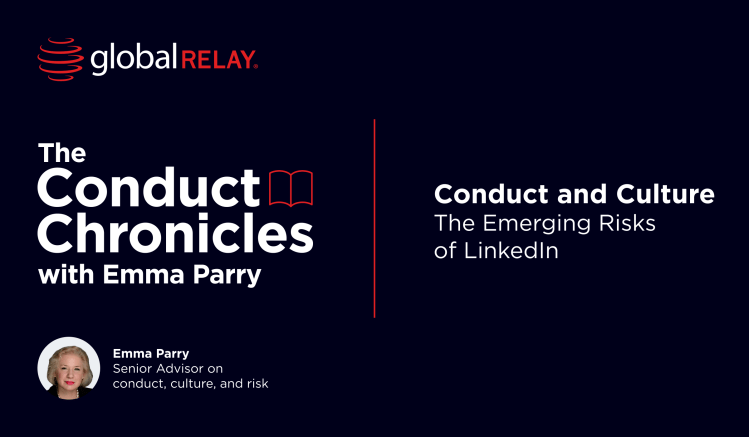
The Conduct Chronicles – The Emerging Risks of LinkedIn
As social media opens up new avenues of communication, businesses face a new set of challenges. From possibilities of insider trading to investment scams, firms must take the necessary precautions to mitigate these potential risks.
Written by a human
Despite an increasing level of regulatory enforcement actions, and the communications surveillance undertaken by firms, misconduct risk continues to emerge on social media and messaging platforms.
Whether it’s market manipulation schemes, non-financial misconduct (eg. bullying, sexual harassment), or unauthorized investment advice from finfluencers, it seems we are surrounded by wrongdoing, scams, alongside fraudsters who are devising ever more creative ways to relieve us of our hard-earned cash.
And it’s not just Telegram, Instagram, WhatsApp, Facebook or even dating sites where the dangers lurk. LinkedIn has evolved from a job hunting and networking site, to one that potentially poses similar risks.
How did we get here?
The Covid pandemic created a perfect storm of opportunity for fraud and scams to thrive on social media and messaging platforms.
Market manipulation such as ‘pump and dump’ schemes proliferated in the day trading boom we witnessed during the pandemic. In fact, there was such a surge that, in September 2020, the Hong Kong SFC estimated that 20% of the market manipulation cases it was investigating were pump and dump schemes. Warnings were also being issued by everyone from the U.S. FBI to the UK’s FCA.
Meanwhile, in Australia, ASIC took matters into its own hands, infiltrating chat groups operated on messaging apps such as Telegram to engage directly with – and disrupt – the people involved in pump and dump activity.
The other trend that emerged around the same time was the rise of finfluencers actively promoting unauthorized investment schemes. Celebrities, alongside industry and social media commentators, were featuring their content on platforms such as YouTube, Tik Tok and Instagram, with some using Telegram to privately share inside tips. When the CEO of the UK FCA name dropped Justin Bieber, J Lo and the Kardashians in his September 2021 speech, you know there’s an issue!
The FCA’s concern about the role of finfluencers is continuing. In October 2024, the regulator announced it was interviewing under caution twenty individuals as part of its targeted action against finfluencers who may be illegally promoting financial services products. The FCA also stated is had issued 38 alerts against social media accounts operated by finfluencers which may contain unlawful promotions.
The concern is shared by other regulators. For example, in the U.S., both FINRA and the SEC have taken recent enforcement action.
This year, FINRA has settled three finfluencer-related enforcement actions (15 March, 3 April, and 10 June). In each action, FINRA alleges that social media influencer posts were not fair or balanced or were inappropriately exaggerated or promissory.
In February 2024, the SEC announced a settled action against a registered investment adviser for not disclosing a social media influencer’s role in the launch of a new exchange-traded fund.
How Firms are Responding
Global Relay’s analysis of financial institutions’ data provides valuable insight into how firms are responding to the risks and the communications data they are capturing as a result. Its latest findings, set out in its 2024 report, demonstrates a dramatic shift in where firms are now focusing.
The report highlights that 400% more firms are capturing generative AI data both in terms of the prompts used and the answers being delivered. And unsurprisingly in the context of the now notorious WhatsApp fines, 258% more firms are capturing WhatsApp communication data.
Countering potential violations of the U.S. SEC Marketing Rule, 87% more U.S. firms are now capturing social media channels and corporate website content.
However perhaps the most intriguing trend is a sharp increase in the number of firms monitoring LinkedIn. In fact, 28% of firms stated they are capturing data from the personal LinkedIn accounts of their employees. Here’s why …
While firms have been addressing the risks of messaging platforms such as WhatsApp, they are now also turning their attention to another platform which, to many industry practitioners, seems a much more benign player – LinkedIn.
Prior to the Covid pandemic, LinkedIn was used primarily as a job-hunting website. However, during the seemingly endless pandemic lockdowns, people were increasingly using the platform to share content, participate in online webinars, and to keep in contact with their valued connections. In a time when we craved connection, LinkedIn helped to fill the void.
However, what is starting to emerge is an acknowledgement that even LinkedIn poses some risks. Here are just three examples:
- Insider Trading. With LinkedIn being one of the few social media platforms available to personnel on business devices, there is a risk that insider trading can be facilitated via its messaging app.
The risk of insider trading is not to be underestimated. In the UK, the FCA’s recent enforcement actions include a criminal prosecution for conspiracy to deal in four stocks while having inside information. In addition, in February this year, a court found an M&A analyst from a global investment bank guilty of six offenses of insider dealing and three offenses of fraud in a case brought by the FCA.
Of note, insider trading is mentioned as a 2025 enforcement priority for ASIC, as well as the SEC. The latter states it will focus on whether firms are fulfilling their obligation to file Suspicious Activity Reports (SARs). Alongside insider trading, SARs can be used to identify and combat various illicit activities including market manipulation, Ponzi schemes, corruption, money laundering, and terrorist financing. - Violations of the U.S. SEC Marketing Rule. This can involve distributing advertisements on the platform that include untrue or unsubstantiated statements of material fact or testimonials, endorsements or third-party ratings that lack required disclosures.
- Investment scams. These are more commonly found on platforms such as Instagram, Telegram and WhatsApp, however, examples are occasionally popping-up on LinkedIn. Recent examples include scams impersonating well-known investment advisors and market commentators. One such impersonation scheme, featuring a fake Martin Lewis, has led to him issuing (yet another) media release, this time in October 2024, highlighting that such adverts are fake. Of course, the surge in AI usage means that impersonation fraud is even easier to commit.
Cat and Mouse
With social media and messaging apps now intrinsic parts of our lives, it is unsurprising perhaps that those same platforms have seen a rise in fraud, scams and market abuse cases. However, regulators are on the case taking enforcement action, and firms are quickly starting to pivot to counter the risks. The question is, in this game of cat and mouse, who will win?



